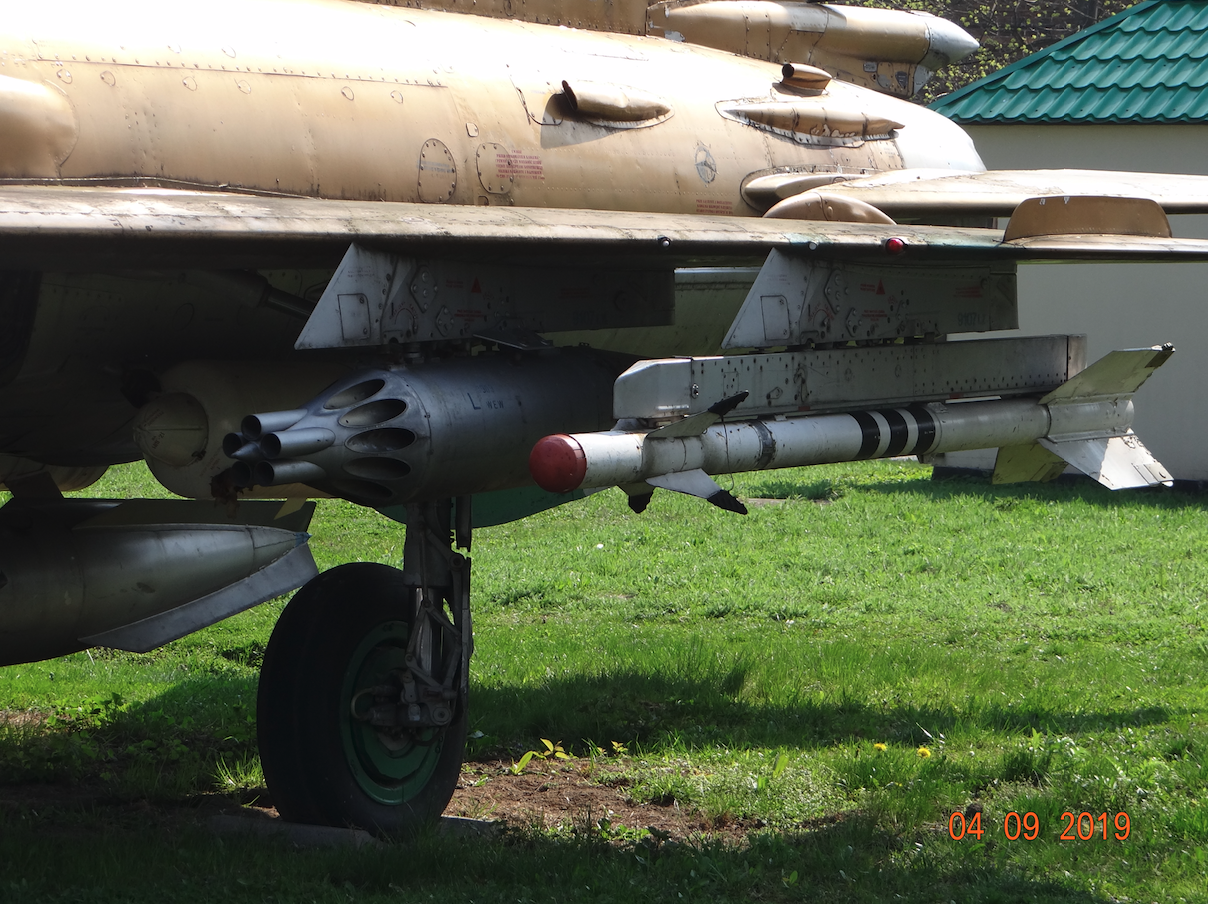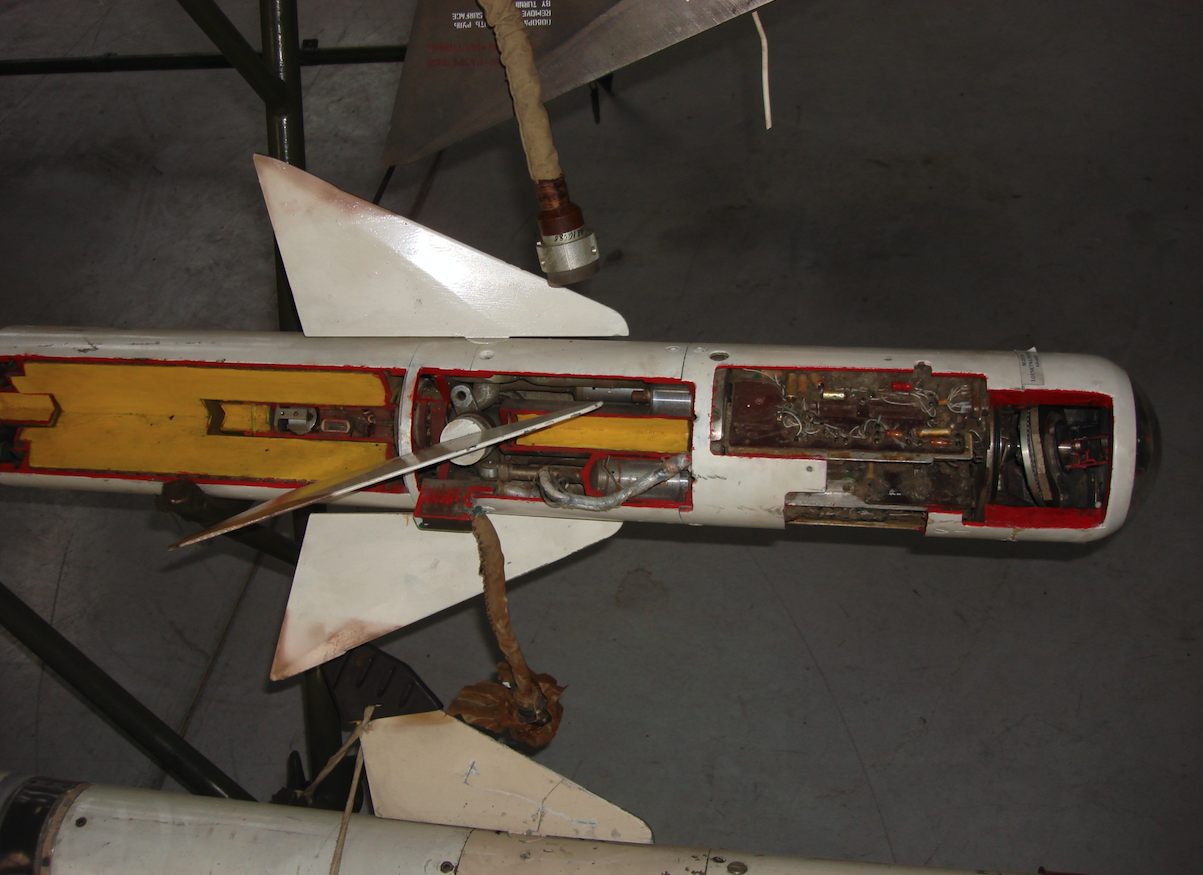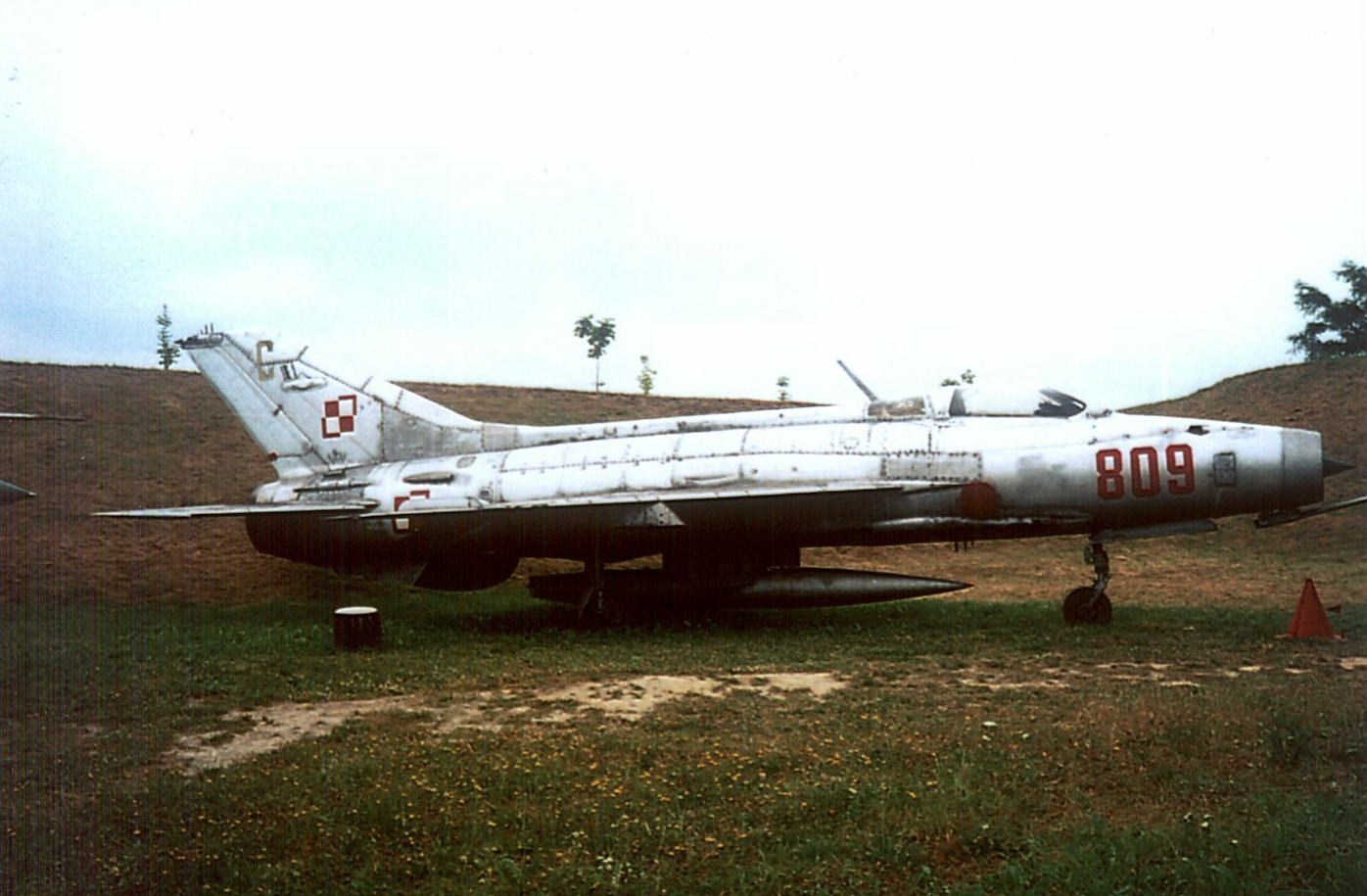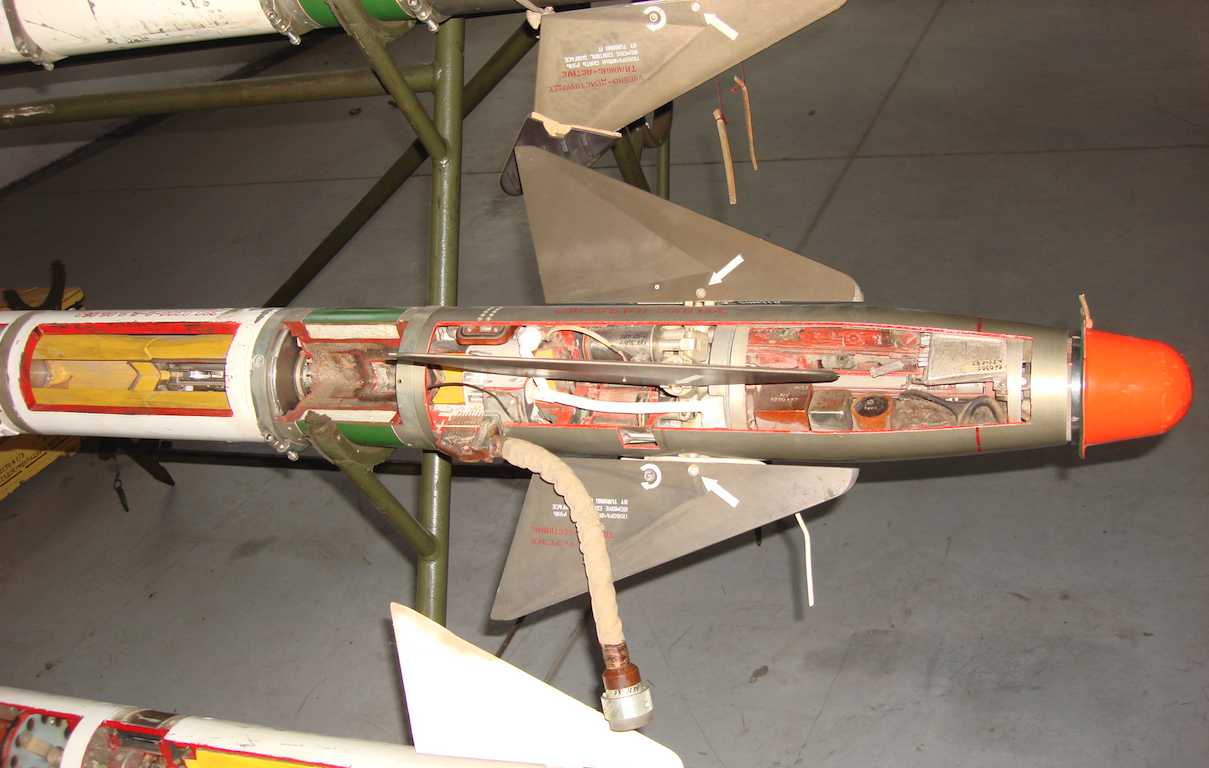Kraków 2020-10-12
R-3, R-13M guided missile.
In the second half of the 50’s, there was a war between China and Taiwan, which was supported by the United States. There were regular air duels between MiG-17 F (China) and F-86 F Saber (Taiwan). The advantage of the victories of the F-86 F planes was huge and amounted to 10: 0. The main contribution to the success was the use of AIM-9B Sidewinder air-to-air guided missiles.
On September 24, 1958, there was a direct hit by an AIM-9B Sidewinder missile of the MiG-17 F plane. However, the missile did not explode and stuck into the plane, it landed with it at a Chinese airport. The Chinese immediately notified Moscow of the incident. The missile was transported to Moscow and by the decision of the CCCP authorities of 1958-10-13, it was copied and put into service.
The Russians were surprised by the American approach to the small missile control system. Until now, the Russians treated the missile as an unmanned aerial vehicle that must be controlled from the outside. As a result, the missiles (such as the RS-1U) were heavy, complex and expensive. The Americans decided to use the thermal energy that the target plane emits, especially its engine exhaust gases. The thermal warhead is only supposed to react to temperature and direct the missile towards the target.
The pace of work in the CCCP in OKB-134 was very fast. Within two years, the new missiles entered service, in 1960. The projectile-copy was marked R-3 (factory designation) K-13 (military designation). Soviet tests showed that the 4.5 kg warhead was too small. The Americans already knew about it and increased the weight of the warhead to 9 kg. The Russians used a warhead weighing 11.3 kg.
In October 1959, the R-3 missiles were tested on SM-12 aircraft, which were development MiG-19 S aircraft. The missiles were mounted on APU-26 launchers, and later on modified APU-13s. The targets were the MiG-15 M unmanned aerial vehicles. After successful tests, it was decided to mount the R-3 (K-13) missiles on the MiG-21 F-13 and MiG-21 P-13 aircraft. The latter had the CD-30T radar sight and the PKI collimator optical sight. The R-3 (K-13) missile was treated as a transitional one and was not produced in large quantities.
From 1962, the R-3S (K-13A) missile was in production. It had a better rocket engine, designated PRD-80A, which increased its operating time from 11 seconds to 21 seconds. The missile range increased from 3,500 m to 7,000 m. In this variant, the missile was mass-produced in CCCP, China (PL-2), Romania and in Poland at ZM Mesko plants.
In the following years, the carriers of the R-3S missiles were all versions of the MiG-21 aircraft, the following planes: MiG-23, MiG-27, Su-17, Su-20, Su-22, Jak-28 P.
Technical description of the R-3S missile.
Although the term – fire and forget – was not used in the 1950s, the R-3S missile belongs to this class. So after firing it, the pilot can perform any maneuver, for example looking for the next target. The R-3S is an air-to-air missile designed to destroy air targets. It fights targets from the rear hemisphere, day and night, in good weather conditions. It is directed by thermal sensors and therefore it is directed to infrared.
The R-3S missile is cylindrical and the aerodynamic system is duck-shaped. So the tail is in the front and the wings are back. The tail and wings are in a cross pattern.
The interior of the missile is divided into five compartments-modules. The first one houses an infrared homing head TGS-K-13 with an optical coordinator in its front part. The optical coordinator picks up the thermal radiation emitted by the target, processes it, and then transmits it to a photodetector made of lead sulphide (PbS). The latter changes them into electrical impulses, analyzed by the head electronics. The first compartment also houses a gyroscopic tracking system. Its installation was necessary due to the limited viewing angles of the optical detector. The cone of his vision is only 3.5 degrees.
The second compartment contains the electronic apparatus and the section containing the rudder actuators, a turbo generator and a gas generator. In the upper part, there is an electrical connector that allows the missile to communicate with the aircraft, transmit feedback signals to the aircraft’s weapon control systems, as well as provide power and control of the steering system before take-off.
The third compartment housed an 11.3 kg high-explosive destroyer warhead, filled with hexogen (phlegmatized TNT). At the moment of the explosion, the body of the charge is torn into 1,000 fragments, hitting the target within a radius of 10 m.
The fourth section housed a NOW optical proximity fuse with 7 photodetectors, the target detection range of which was 9 m.
The fifth compartment is a PRD-80A rocket engine with a thrust of 37 kN. The drive unit runs on a solid fuel based on nitrocellulose and nitroglycerin. The engine operation time was 1.7-3.3 s. During this time, the rocket accelerated to the speed of 700 m / s. At the back of the missile, you can install smoke generators to observe the missile’s flight.
The wings are equipped with gyro ailerons responsible for stabilizing the rotational speed of the projectile around the longitudinal axis.
The missile has two detonators. The first is a proximity fuse. The second is percussion with sensors at the ends of the control surfaces. The missile self-destruct system works after 23-28 seconds.
The missile has three attachments for attachment to the APU-13 or APU-13U-1 launcher. The APU-13MT beams are used in the MiG-23 planes. After firing, the missile begins guided flight after 0.4-0.7 seconds. The deflection of the rudders is calculated by the electronics of the thermal homing head TGS on the basis of the signal analysis from the photodetector.
R-3S missile attack procedure.
After detecting the target, the pilot takes its position in the rear zone of the target. The optical coordinator is blocked until the projectile exits the APU-13 launcher. The pilot places the target in the center of the sight. After light and sound confirmation from the control system that the missile head sees the target, the missile may be launched. Before launching the rockets, the pilot must make sure that the speed of his aircraft meets the conditions for the use of the rocket and that the overload limits for the use of R-3S are not exceeded.
When the firing button is pressed, the pyrotechnic gas-generator is activated, which drives the generator and enables the rocket rudders to function. Then the rocket power is automatically switched to the internal source, i.e. the generator.
Then, the optical coordinator is unlocked and the engine is started. The missile overcomes the breech resistance, descends from the launcher and after a time of 0.4-0.7 seconds it started to move towards the target. Before the end of the rocket engine operation, both fuses are armed. In the case of a direct hit, the explosion was initiated by a shock fuse. When a target passes within the target’s detection range by a proximity fuse, it initiates the explosion of the warhead.
The missile will not intercept a maneuvering target with an overload greater than 2g. The projectile is not resistant to thermal traps (flares) and direct sunlight. The bullet misses the target when it flies into the clouds. The projectile may pump the engine of the host aircraft. Therefore, in Poland, MiG-23 planes did not carry R-3S missiles under the fuselage. In addition, a low altitude carrier should be above 800 km / h and at high altitude over 550 km / h.
Basic data of the R-3S missile:
The entry into service was in 1960. Projectile diameter 0.127 m. Length 2.84 m. Wingspan 0.528 m. Weight 75.3 kg. Head weight 11.3 kg. Minimum use ceiling 1,000 meters. Maximum use ceiling 21,500 meters.
Polish MiG-21 F-13.
The MiG-21 F-13 is the first variant of the MiG-21 aircraft purchased by the Polish Army. Only new airplanes, produced by CCCP at the Gorki plant, were delivered to Poland. The plane has an R-11F-300 engine with a thrust of 1 x 3 822 kG and an afterburner of 1 x 5 625 kG as a propulsion. The aircraft does not have a radar sight (radar station). The first plane was brought to Poland on 1961-09-29. The plane had the serial number 741217 and received nb 1217. A total of 25 MiG-21 F-13 aircraft were delivered to Poland. R-3S missiles were delivered together with the MiG-21 F-13 aircraft.
R-13M (K-13M) missile.
The AIM-9D missiles obtained in North Vietnam were handed over to Soviet designers. As a result, a new guiding head, which is cooled with nitrogen, was copied. The projectile’s propulsion unit was also replaced. The revised missile was designated R-13M (K-13M).
The R-13M (K-13M) missile has a warhead cooling system with nitrogen. The nitrogen cylinder was placed in the beam-launcher. The warhead received the designation Szron-70. The head has a higher photodetector sensitivity. The target detection distance has doubled. The optical coordinator has been reduced. The shape of the front part of the projectile has changed, to be more slender. The projectile can be fired at an overload of up to 3.7 g. The increase in the rocket’s range was achieved by replacing the engine with the PRD-280 unit, which also runs on solid (heterogeneous) fuel. The engine thrust increased to 58.8 kN. The runtime increased to 3.3-5.4 seconds. The proximity fuse has been improved. The gas generator runs three times as long. Control surfaces and wings have been increased. The warhead received 144 steel bars that increase the destructive effect. Projectile self-elimination takes 60-65 seconds.
As there was still a problem with pumping the engine of the carrier, the projectile received a special ring on the outlet nozzle, which causes the projectile to leave the flight path, thus limiting gas suction. The basic limitations of the missile, however, remained, although effectiveness increased.
The missiles are used by the MiG-21 M, MiG-21 MF, MiG-21 bis, MiG-23, MiG-27, Su-20, Su-22 and Su-22 M planes. Beams are used to launch the R-13M missiles APU-13MT suspensions, which could also fire the older R-3S missiles.
R-3R (K-13R) missile.
Since the Soviet designers expected the failure of the R-3S missile program, work on a version with semi-active radar guidance was started in parallel. The PARG-13MWW homing head directs itself to the target using the reflected high-frequency radio signal emitted by the host’s radar. The missile was designated R-3R (K-13R). The missile uses many elements from the R-3S missile. The basic distribution of elements inside the missile, known from the R-3S, has been preserved. The length of the rocket increased by as much as 0.58 m. The shape of the frontal part of the missile has changed, and it is now a sharp cone made of a material transmitting radio waves.
The missile must be used only with the RP-22 Sapfir radar sight. A radar station is necessary because the guidance head distinguishes the target from the surroundings based on the reflected high-frequency radio signal from it, the source of which is the aircraft’s radar transmitter. This process is called target highlighting. This process is carried out automatically by the radar sight and continues until the missile hits the target.
The R-3R (K-13R) missiles also have limitations. The work of the host’s radar exposes the attack. You can disrupt the radio signal of a radar station by emitting false radio tracks.
The R-3R missiles have been used on MiG-21 S, MiG-21 MS, MiG-21 MB, and MiG-21 bis aircraft since 1966. The R-3R missile uses the APU-13U-2 beam. The R-3R missiles were also used in Poland on MiG-21 MF and MiG-21 bis aircraft.
Written by Karol Placha Hetman







